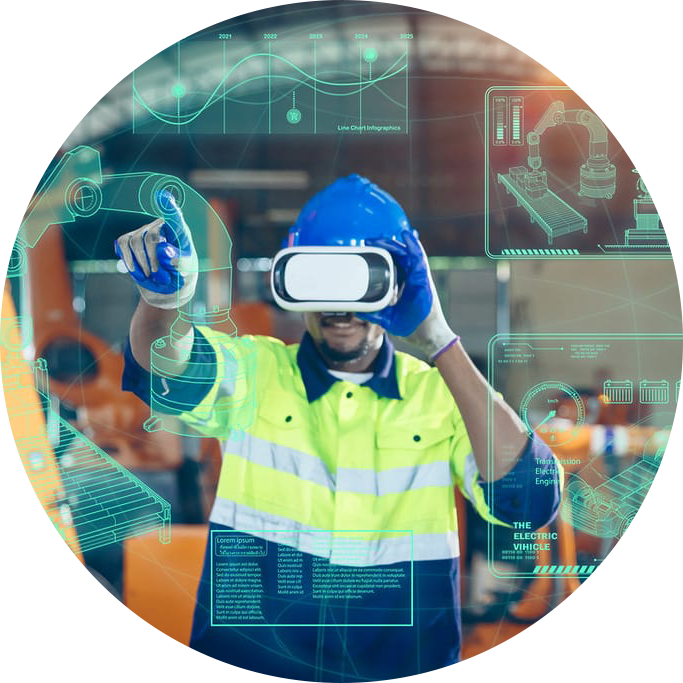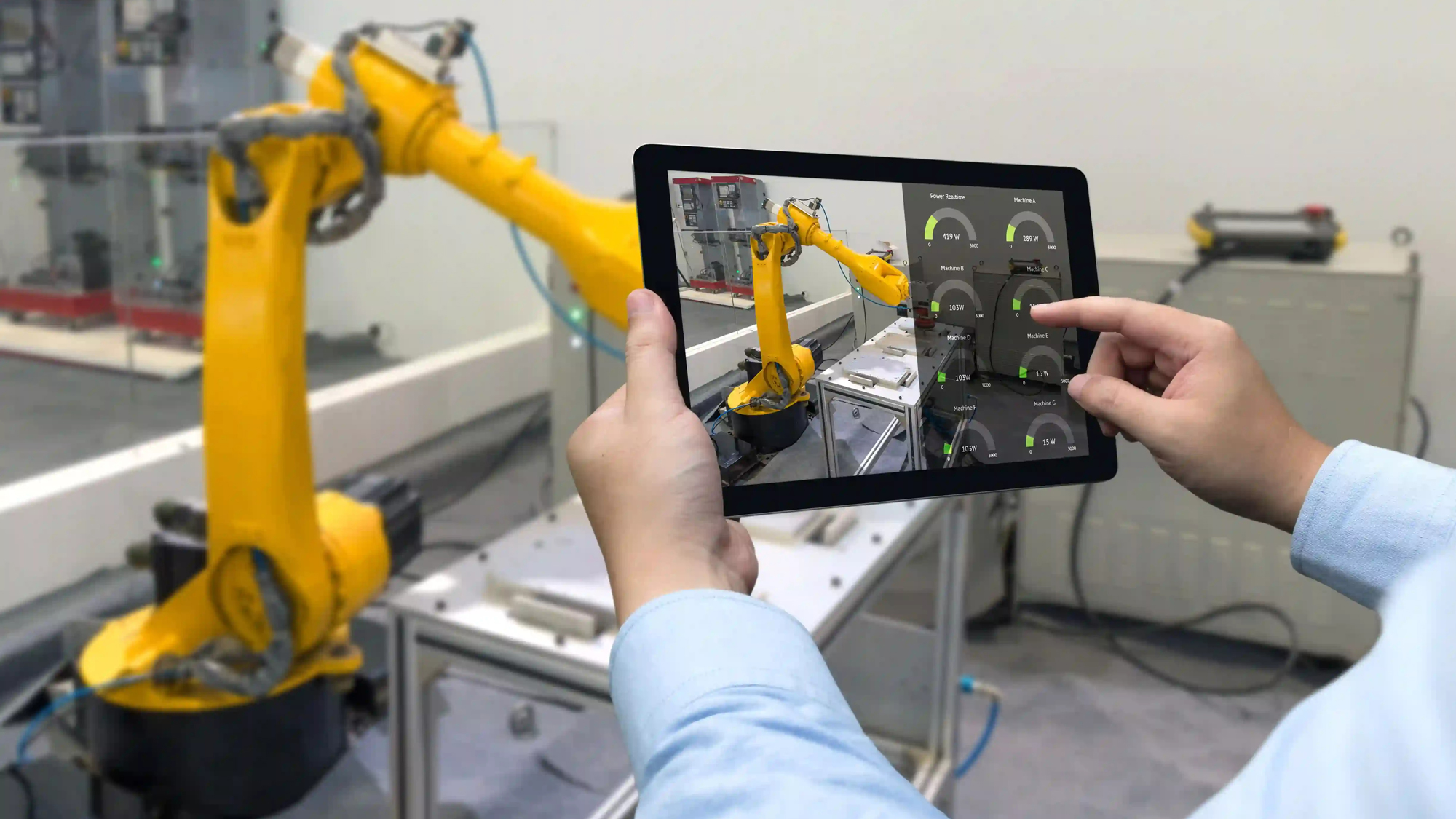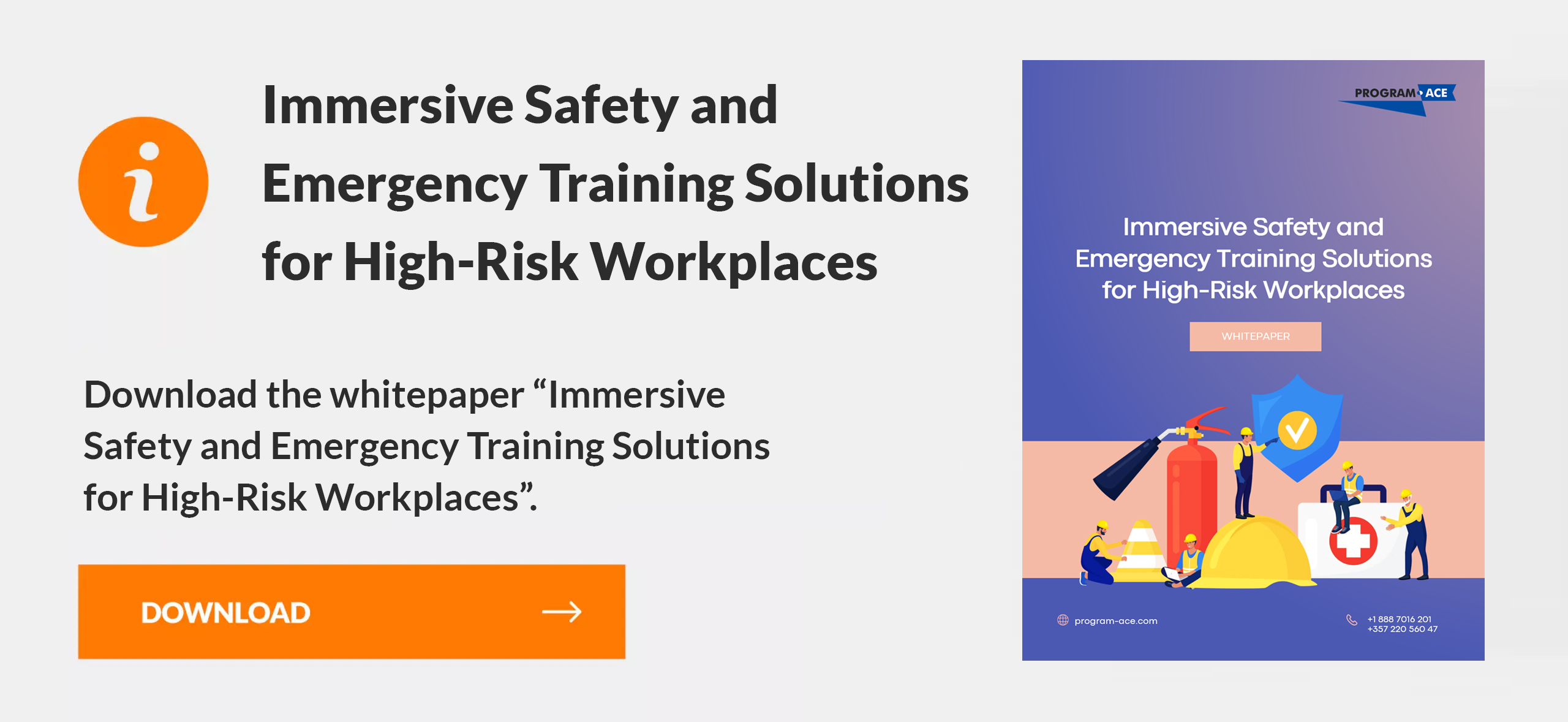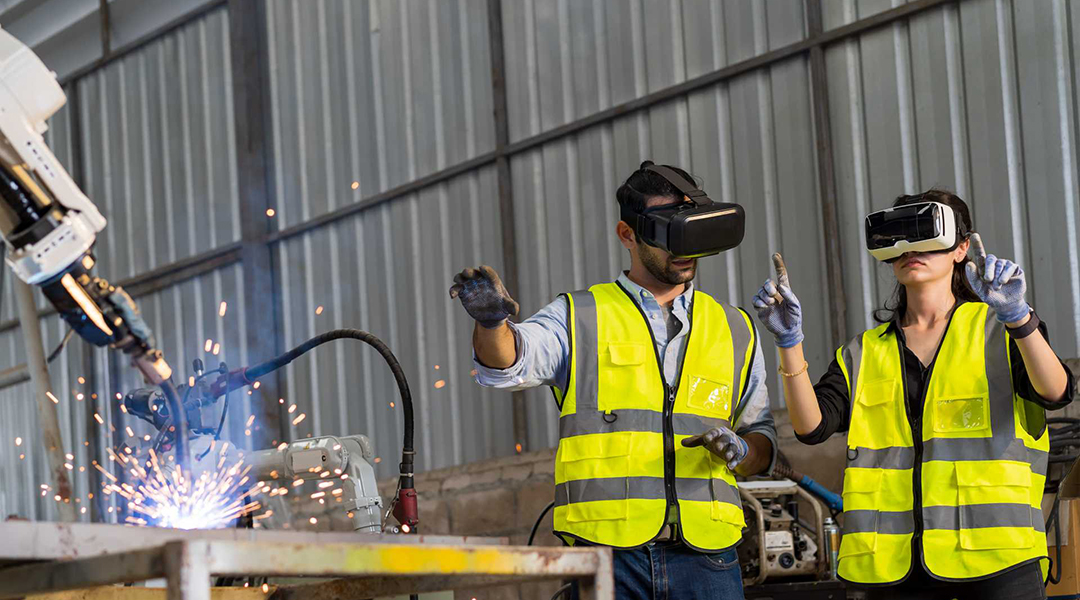Manufacturing safety training must be practical, specific, and designed for real conditions. Companies that rely on manual processes, machinery, or chemical handling face daily risks that demand more than printed manuals or short lectures. Accidents, equipment misuse, and compliance failures cost money, delay production, and increase insurance costs. Traditional training often misses the mark because it doesn't reflect what workers actually face on the floor.
Virtual training solutions offer a better approach. Workers interact with digital scenarios based on actual hazards, tools, and procedures. Unlike passive learning, this method gives employees a chance to make decisions, spot issues, and react to simulated emergencies. As a result, mistakes become part of the learning experience, not part of production downtime. Training performance can be measured, repeated, and adjusted based on the role or site.
Adopting virtual training solutions doesn't just help you meet safety standards. It reduces onboarding time, limits downtime due to injuries, and lowers retraining costs after incidents. The goal is simple: improve daily safety outcomes and protect your workforce with training that matches real manufacturing environments.
Who Needs Manufacturing Safety Training?

Manufacturing safety training is essential for anyone working in or around production areas. Safety is not limited to one role or department. Every person who interacts with equipment, materials, or workflows that carry risk should be trained to handle those situations correctly from day one.
Below is a clear breakdown of who benefits most from structured safety instruction:
- New employees. Even if someone has years of manufacturing experience, they still need to learn your procedures, machinery, and layout before starting work.
- Equipment operators. Workers who manage conveyors, presses, or CNC machines face mechanical hazards daily and require task-specific safety skills.
- Forklift and vehicle operators. Anyone driving within a facility must know proper inspection routines, path rules, and load limits.
- Maintenance staff. Repairs and inspections often involve energy sources, moving parts, or hazardous substances.
- Supervisors and line leads. They must monitor safety compliance, identify unsafe behavior, and step in during incidents.
- Temporary or seasonal workers. Short-term staff still face the same risks and cannot be expected to learn safety procedures informally.
- External contractors. Workers brought in for repairs, upgrades, or inspections must understand your site's specific safety rules.
Immersive manufacturing training allows all of these groups to practice real decisions in controlled environments. It replaces assumptions with certainty and builds consistent safety behavior across your team.
Benefits of Investing in Virtual Manufacturing Safety Training
Effective safety training solutions reduce accidents, improve workflow, and help you meet compliance requirements without disruption. When training is clear, job-specific, and consistent, employees work more confidently, fewer mistakes happen, and your facility operates with less risk. You save time, avoid legal trouble, and retain qualified staff who know how to act in critical situations.
Fewer Downtimes and Reduced Lost Time Injuries
Production lines stop every time someone gets injured, even if the incident is minor. Delays lead to missed orders, additional costs, and strained teams. Lost-time injuries require documentation and internal reviews and often force a shift in team responsibilities while the injured worker recovers.
With structured virtual safety training in place, your staff knows how to prevent common incidents before they escalate. Practical sessions based on real equipment and environments give employees a chance to learn reactions without pressure. Virtual safety training solutions allow running realistic hazard drills without exposing anyone to actual harm. That improves performance in real situations and keeps machines running and teams focused. A safer floor also reduces replacement costs and lessens the burden on your HR or operations team.
Lower Insurance Premiums Through Risk Mitigation
Insurance providers assess risk based on your claim history, training records, and safety incident trends. Your company becomes a lower-risk client when your team completes consistent safety training that aligns with current regulations. That often leads to lower premiums or better renewal conditions.
Improved hazard awareness and proper equipment handling can also reduce the total number of claims. With fewer incidents reported and better documentation of preventive measures, providers may offer tailored coverage instead of charging for worst-case expectations. Companies using digital or virtual safety training solutions often provide detailed logs, timestamps, and competency data, which gives insurers confidence in the system's effectiveness.
Boosted Retention and Workforce Morale
Workers stay longer when they feel safe, respected, and properly trained. Safety training is one of the clearest ways to show that employee well-being matters. Job satisfaction increases when each team member is given tools to succeed and avoid injury.
Virtual training also reduces confusion and builds trust. New hires feel more prepared, and experienced workers see that everyone is held to the same standards. Virtual training can help by offering consistent content, visual demonstrations, and repeatable practice sessions. That levels the field across shifts or departments. A safer environment supports a more stable workforce, lowers recruitment costs, and helps teams perform without constant interruption or fear of injury.
| Aspect | Traditional Training | Digital Training |
| Delivery Format | Paper manuals, videos, classroom sessions | Interactive software, simulations, VR-based environments |
| Engagement Level | Mostly passive, limited interaction | Active participation through tasks and decisions |
| Realism | Low. Focused on theory and basic procedures | High. Simulates actual tools, hazards, and emergency events |
| Adaptability | One-size-fits-all content | Custom modules based on job role and environment |
| Feedback and Tracking | Manual testing, often delayed | Immediate performance tracking and detailed reports |
| Cost Efficiency Over Time | Recurring instructor fees and printing | Higher initial cost but scalable and reusable |
| Effectiveness for Skill Gaps | Difficult to adjust quickly | Easy to update and personalize based on performance data |
Many manufacturers now work with virtual reality safety training companies to build immersive programs that match real-world conditions.
Where Traditional Training Still Works
Traditional training formats still have a role, especially in settings where technology access is limited, or regulations require instructor-led certification. Some safety topics, like CPR or fire extinguisher use, are often delivered effectively through live demonstrations. Printed materials and in-person sessions may be more practical in smaller operations or remote areas than setting up digital platforms.
Certain workers also retain information better through verbal explanation or repetition in a physical environment. For example, training for routine tasks with low variation might not require immersive content. In highly regulated industries, some certifications still require written exams or instructor approval. Traditional formats can also be helpful when cultural or generational preferences favor face-to-face instruction.
When companies use traditional methods effectively, they usually combine lectures with walkthroughs or small group practice. The key is keeping sessions focused, measurable, and directly tied to what employees do daily.
How VR, AR, and eLearning Close the Experience Gap
Digital formats fill major gaps that traditional training cannot address. Technologies like virtual reality (VR), augmented reality (AR), and eLearning provide realistic, repeatable scenarios that help employees practice decision-making in high-risk situations. Instead of watching a video or reading instructions, workers complete tasks in simulated environments that look and behave like their actual job sites.
VR, for example, allows someone to operate machinery, respond to emergencies, or identify hazards without facing any real danger. AR adds digital information to physical environments, guiding users step by step through equipment checks or safety procedures. eLearning platforms deliver structured lessons with quizzes, video walkthroughs, and instant feedback.
These formats are also scalable and consistent. You can train hundreds of workers across different sites with the same materials, tracked in real time. Virtual reality safety training companies have made this approach more accessible by offering industry-specific modules and support for integration with internal systems.
Why Safety Training in the Manufacturing Industry Still Fails
Many safety programs in manufacturing fall short because they rely on outdated formats, general content, and limited tracking. Workers often sit through sessions that do not match their real job risks. Without practical relevance, training is quickly forgotten. Employers may also struggle to measure how well training translates into safer behavior. Using virtual reality in manufacturing helps fix those gaps, but many companies still stick to older systems that don’t support modern needs.
Outdated Content and One-Size-Fits-All Approaches
When training materials no longer reflect your equipment or procedures, workers tune out. If everyone gets the same slides regardless of role or risk level, the outcome is poor retention and low engagement.
Common issues with outdated training:
- Generic materials. Same session for roles with completely different safety risks.
- Static content. No updates based on regulation changes, incidents, or feedback.
- No task alignment. Courses don’t reflect what workers do each day.
- Low credibility. Employees stop taking sessions seriously when examples feel irrelevant.
Virtual reality in manufacturing lets you create custom programs tied to actual layouts, machinery, and job tasks. That brings the training back into focus and restores its value.
Gaps Between Training and On-the-Job Behavior
Training often fails not because it was wrong but because it wasn’t reinforced. Workers return to the floor without the confidence or practice needed to apply what they learned.
Main reasons behavior doesn’t change:
- No practical application. Lessons don’t include simulation or real-time decisions.
- Shortcut habits. Workers fall back on what feels faster or easier.
- One-time events. Training happens once per year, with no follow-up or support.
- Lack of accountability. Supervisors don’t always monitor the correct application of safety steps.
Using job-specific simulations makes training more than a one-time lecture. It turns learning into action and helps build better long-term habits.
Lack of Measurable Performance Metrics
When you don’t know how well someone understood the training, you can’t know if they are ready. Most traditional methods only confirm attendance, not comprehension or skill.
Problems with untracked training:
- No visibility. You can’t see who struggled or skipped key sections.
- No comparisons. It’s impossible to tell which training formats work.
- No early warnings. Risk builds up unnoticed until an incident occurs.
- No guidance. There’s no data to support when to refresh or revise content.
Digital platforms and simulation-based tools offer detailed tracking. You see how people perform in safety drills, how quickly they respond to hazards, and what topics need more focus.
Choose your best manufacturing safety training with us.
What Effective Virtual Safety Training for Manufacturing Looks Like

Strong safety training programs in manufacturing focus on real risks, not theory. They give your team the tools to handle daily tasks with fewer errors, stronger awareness, and faster reactions. Instead of showing generic slides, the training must reflect the actual machines, layouts, and situations your staff faces. Effective solutions provide consistency, track progress, and adapt to different roles. When done right, safety training becomes part of the workflow, not an interruption to it.
Scenario-Based Learning for Real-Life Situations
Training must prepare workers for what they will experience. General instruction does not work in fast-paced or high-risk environments. Workers need to know how to respond when something goes wrong, not just what the manual says.
Why scenarios work:
- Familiar settings. Training happens in environments that look and function like your plant.
- Task-specific. Each simulation reflects actions tied to a real role or tool.
- Mistake-based learning. Employees learn from decisions without real-world consequences.
- Repeatable. Workers can retake lessons until they show strong performance.
Scenario-based learning helps close the gap between knowing the rules and using them under pressure. When someone is trained using realistic challenges, they are more likely to act correctly in a critical moment, improving both safety and productivity on the floor.
Cross-Device Access for On-Site and Remote Staff
Manufacturing operations often run across shifts, buildings, or locations. Not every worker sits at a desk, but everyone still needs consistent safety instruction. Training tools must work across different devices and job setups.
What cross-device access enables:
- Flexible training. Workers can complete modules from tablets, laptops, or mobile devices.
- Equal access. Everyone receives the same content, regardless of location or schedule.
- Easier updates. Content can be revised and delivered instantly without printing or meetings.
- Remote support. Off-site teams or contractors get training before arriving on-site.
When safety content works on any device, your team trains faster and with fewer delays. You save time, avoid bottlenecks, and ensure that training is done before risk increases. Inconsistent access leads to inconsistent behavior, while cross-device delivery helps solve that.
Virtual Manufacturing Safety Training Solutions to Check Out
Modern safety training in manufacturing relies on immersive, hands-on simulations that address general and role-specific risks. The following solutions cover various operational hazards and compliance-critical skills that workers must master to ensure a safe, efficient workplace.
- Pre-Trip Inspection. Teaches how to perform safety checks on vehicles before operation to prevent mechanical failures.
- Lock-out/Tag-out. Trains workers to properly shut down and secure machinery during maintenance to avoid accidental startups.
- General Hazard Recognition. Improves awareness of common safety risks present in manufacturing environments.
- Forklift Fundamentals Training. Provides instruction on safe forklift operation, including maneuvering and load handling.
- Fire Safety. Covers how to identify fire hazards, use extinguishers, and follow emergency protocols.
- Fall Safety. Prepares workers to identify fall risks and use fall protection systems properly.
- Warehouse Safety. Focuses on collision prevention, storage safety, and traffic management in warehouse settings.
- Forklift Hazard Recognition. Enhances ability to detect and respond to hazards during forklift operation.
- Forklift Pre-Operational Inspection. Trains workers to inspect equipment before use to prevent malfunctions.
- First Aid. Teaches how to respond to medical emergencies and administer basic treatment.
- Workplace Safety. Covers general safety practices across manufacturing floors.
- Arc Flash (Flashover). Educates workers on identifying and responding to electrical flashover hazards.
- Truck Preparation for Driving. Focuses on vehicle readiness and pre-departure safety routines.
- Maintenance Safety (Pipes and Acids). Addresses safety procedures when working with corrosive materials and piping systems.
- Work at Height. Trains on fall protection and safe practices for elevated tasks.
- Lockout Tagout (LOTO). Reinforces safe energy isolation procedures during equipment servicing.
- Load Slinging. Teaches how to safely rig and sling loads for crane or hoist lifting.
- Hot Work. Covers precautions and safety steps for welding, cutting, or grinding tasks.
- Fire Safety (Office). Adapts fire prevention protocols for office-based manufacturing areas.
- Fire Safety (Hangar). Tailors fire safety measures for hangars and large industrial structures.
- Electrical Safety. Teaches how to work around energized equipment without risk.
- Confined Space Entry. Prepares workers for safe entry and operation in limited-access areas.
Components of Immersive Safety Training Programs for Manufacturing Companies
A complete safety training program includes more than just general advice or reminders. It must meet legal standards, prepare workers for real scenarios, and reinforce correct actions around equipment, chemicals, and hazards. Strong programs are structured, trackable, and built around what workers need to know, not just what looks good on paper. For manufacturing companies, the focus should always be on job-specific risks, measurable outcomes, and compliance with regulatory requirements.
Compliance with OSHA and ISO Standards
Regulatory compliance is not optional. Failure to meet OSHA or ISO safety requirements can lead to fines, production delays, and reputational damage.
Key compliance features to include:
- Clear references. Training must align with the latest OSHA and ISO guidelines.
- Audit readiness. Programs should generate records that show training history and results.
- Role-based instruction. Employees learn only what applies to their specific duties.
- Policy integration. Training supports your documented safety procedures.
Without structured compliance training, proving that you’ve met your legal obligations is difficult. Digital systems help by automatically logging completions, test scores, and refresher timelines. This not only prepares you for inspections but also shows workers that real standards back safety.
Hazard Identification and Incident Simulation
Every worker should have the basic skill of spotting danger before it causes harm. Yet many programs only cover this theoretically, using static images or lists. Simulation-based learning offers a better way.
Effective hazard training should include:
- Realistic visuals. Workers view risks in a factory-style environment.
- Time-based response. Simulations test how quickly and accurately users react.
- Multiple scenarios. Training covers both common and rare hazards.
- Immediate feedback. Learners see what they missed and how to improve.
When employees practice identifying and responding to hazards in a simulation, they are far more likely to repeat those actions on the job. Incident simulation also helps you see how well each person applies their training. Instead of assuming someone is prepared, you’ll have evidence.
PPE Protocols and Equipment Handling
Incorrect use of personal protective equipment (PPE) is a top cause of avoidable injuries in manufacturing. Many workers do not know what gear to wear or how to inspect it. The same applies to tools and heavy machinery.
Focus areas for this module:
- PPE selection. Teach which gear is needed for which tasks.
- Usage checks. Show how to inspect PPE for wear or damage.
- Safe handling. Demonstrate how to operate machines according to safety steps.
- Storage rules. Explain where and how to store both PPE and equipment.
Interactive programs help workers apply PPE and operate tools in the correct sequence. Rather than guessing or copying others, they get clear instructions with hands-on practice. Reinforcing these routines cuts down on small mistakes that often lead to larger problems.
Emergency Response Preparedness
When something goes wrong, the first few seconds matter. Workers must know what to do, where to go, and how to act without waiting for instructions. Emergency response training must cover multiple situations, not just fire drills.
What good response training includes:
- Evacuation steps. Teach how to exit quickly and safely.
- First action. Show what to do before help arrives, including alarms or shutoffs.
- Communication protocols. Explain how to report incidents clearly and fast.
- Role assignments. Assign responsibilities for staff like fire wardens or first responders.
Virtual simulations can walk employees through emergencies without real danger. Workers learn to recognize alarms, identify exits, and follow correct sequences. You build both awareness and confidence, reducing panic and confusion when real incidents occur.
How to Choose Safety Training Programs for Manufacturing Companies

Choosing the right virtual safety training program means looking beyond surface features. You need content that matches your industry, tools, and risks. It should be easy to update, flexible enough to grow with your team, and practical for both in-house staff and outside contractors. Generic courses won’t protect your workforce or meet your compliance goals.
Vetting Content Providers for Industry-Specific Knowledge
Many training providers offer general content that sounds good but lacks relevance to manufacturing work. Before choosing a vendor, ensure they understand the equipment, processes, and safety issues in your facilities. Ask whether their materials include role-specific scenarios and whether they’ve worked with manufacturing clients.
Generic programs created for office settings or unrelated industries will not prepare your team for high-risk situations. Providers should also be open to customizing the training content based on your plant layout, procedures, or compliance needs. If the vendor cannot clearly explain how their program applies to your staff’s responsibilities, it’s a sign they’re not the right fit. Manufacturing safety training must reflect real tasks, not just general principles.
Ensuring Program Scalability and Localization
Immersive safety training must grow with your team. If your workforce expands, shifts to new equipment, or starts operating in new regions, the training platform must be ready to adjust. Programs should support different job levels, from entry-level workers to supervisors, without requiring a full rebuild each time. In multilingual teams, all training content should be available in the native languages of your staff, not just translated summaries.
It’s also important that content can be updated quickly in response to new regulations or safety findings. A program that works well for one site but fails in another creates gaps and inconsistencies. Reliable training tools offer centralized management, easy location duplication, and real-time updates. That helps ensure every worker gets accurate and timely instruction regardless of when or where they join your operation.
Manufacturers Transforming Outcomes with Structured Virtual Training
Companies that invest in structured safety training programs see measurable improvements in productivity, retention, and incident reduction. Real results come from using targeted content, role-based simulations, and modern delivery methods. The following examples show how manufacturing organizations have improved operational performance and reduced risk by replacing outdated methods with focused, structured training systems.
Electronics Manufacturer Reduces Onboarding Time by 45%
An electronics manufacturing facility in Cork, Ireland, reduced new employee onboarding time from ten months to just eight weeks by switching from paper-based materials to a digital training system. The company introduced interactive e-learning modules covering technical tasks such as soldering, component testing, and electrostatic safety.
By using structured content and real-time feedback, new hires reached performance benchmarks faster and with fewer errors. Employees could review lessons on demand, track their progress, and receive immediate guidance when mistakes occur. Supervisors also benefited from performance data that helped identify which topics needed more focus during follow-ups. With this system in place, the manufacturer improved first-year retention rates and reduced downtime caused by training delays.
Automotive Plant Reduces Motor Vehicle Accidents by 50%
Dow Chemical’s Hydrocarbons and Energy business unit focused on reducing vehicle-related incidents by applying structured Six Sigma methods to driver safety. They identified specific behavior patterns and environmental conditions that contributed to risk and then built targeted interventions into their training programs.
Over time, the company achieved a 50% reduction in motor vehicle accidents per million miles driven. The new training included scenario-based instruction, defensive driving simulations, and a more personalized operator feedback loop. These changes helped employees recognize risky behavior early and respond appropriately under pressure. The success of this approach demonstrates how data-driven training paired with specific operational insights can deliver fast, sustainable safety results.
Food Processing Facility Enhances Safety Training with Simulations
Food Processing Skills Canada launched a virtual training initiative to improve food and beverage industry safety outcomes. Through immersive simulations, workers learned to identify hazard zones, apply sanitation procedures, and follow response protocols. The VR-based approach allowed employees to interact with lifelike production environments without the risk of injury.
By practicing everyday tasks under simulated conditions, trainees gained confidence and retained knowledge more effectively than with slides or lectures. The program supported multiple languages and was tailored to real job roles, which helped boost engagement among diverse teams. Companies implementing the training reported stronger audit outcomes and fewer repeat violations within a year of the rollout.
Final Checklist Before Launching Your Next Virtual Safety Training for Manufacturing
Launching an immersive safety training program without full preparation leads to poor results and avoidable delays. To make sure your training has a real impact, every part of the process must be ready, from the content itself to the way your team accesses it. Use the checklist below to verify that your program is accurate, relevant, and fully operational before rollout.
Final checklist for safety training readiness:
- Define the goal. Know whether you're targeting compliance, onboarding, or upskilling.
- Match content to real risks. Verify that training reflects your actual machines, workflows, and site layout.
- Ensure compliance alignment. Confirm that all materials follow current OSHA, ISO, or regional safety standards.
- Test delivery platforms. Check that VR systems, LMS tools, or mobile access work across all shifts and devices.
- Activate tracking features. Confirm that completion, performance, and assessment data are recorded automatically.
- Include multilingual options. Make sure language settings are available if your workforce is diverse.
- Train team leads. Prepare supervisors to support the training and answer questions from staff.
- Pilot the program. Run a short test with a small group to identify technical or content issues.
- Schedule refreshers. Plan recurring sessions in advance to reinforce safety habits over time.
Checking every point on this list helps avoid wasted hours, incomplete records, and gaps in worker preparation. A safety program only delivers results when it's both well-designed and fully supported across your team.
Program-Ace's Immersive Solutions to Make Safety Training Pay Off
As an innovative solutions integrator, Program-Ace delivers safety training systems for real manufacturing environments. Our focus is on building tools that reduce incidents, improve retention, and meet compliance standards without interrupting operations. Every solution is built to be measurable, scalable, and easy to use across different roles and locations.
We provide immersive virtual training programs tailored to your equipment, workflows, and risk factors. Instead of generic content, your team receives scenario-based simulations that reflect real decisions they face each day. All progress is tracked through built-in analytics, giving you clear visibility into performance and training completion.
Our systems support multi-language content, cross-platform delivery, and rapid updates. That means you can onboard new employees, reskill your current staff, and maintain compliance across all locations without delays or repeated sessions. You also gain access to customization tools that let you adjust training content as your processes evolve.
Contact us to learn how Program-Ace can support your safety goals with practical, role-specific training that delivers measurable results.
























